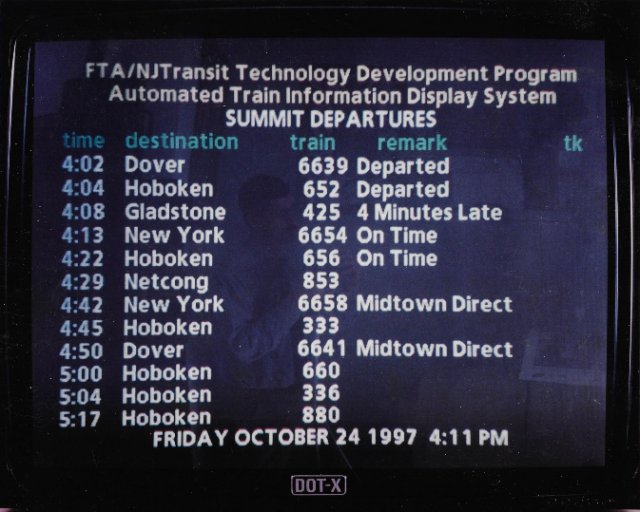Project/Program Name: Automated Train Information Display System
Description: Pioneered automated real time information for commuter rail service under an FTA research grant.
Software was developed for calculating real-time train status in an automated train information display system (ATIDS). Interfaces were developed for passing schedules and real-time train position and routing data from a rail traffic control system (CTC) to the ATIDS equipment. The technology was integrated into a fully automated multi-track display and annunciation system and successfully demonstrated in 1997.
To address the issue of customer requirements for real-time information, market research was conducted with a series of 9 focus groups comprised of both frequent and infrequent riders. It was found that many of the transit industry’s most common display formats contain information of no value to customers, that information was often being provided in a needlessly cumbersome manner, and that several of the customers’ more critical information needs had not yet been considered by the industry.
Software was developed for calculating real-time train status in an automated train information display system (ATIDS). Interfaces were developed for passing schedules and real-time train position and routing data from a rail traffic control system (CTC) to the ATIDS equipment. The technology was integrated into a fully automated multi-track display and annunciation system and successfully demonstrated in 1997.
To address the issue of customer requirements for real-time information, market research was conducted with a series of 9 focus groups comprised of both frequent and infrequent riders. It was found that many of the transit industry’s most common display formats contain information of no value to customers, that information was often being provided in a needlessly cumbersome manner, and that several of the customers’ more critical information needs had not yet been considered by the industry.
Owner: NJ TRANSIT
Stakeholder Agencies/Departments/Suppliers: NJ TRANSIT Planning, NJ TRANSIT Rail Operations, NJ TRANSIT Customer Service, Federal Transit Administration, Com-Net Software Systems
Involvement: system engineering, project management, quality assurance, project controls (as NJ TRANSIT employee)
Results Achieved: Operational tests revealed that the quality of the data received from the rail traffic control system was insufficient for passenger information purposes. Often, the CTC system knew that a train was present (sufficient for train dispatch purposes), but not which train it was (required for passenger information). Market research revealed that many of the transit industry’s most common display formats contain information of no value to customers, that information was often being provided in a needlessly cumbersome manner, and that several of the customers’ more critical information needs had not yet been considered by the industry. Lessons learned were incorporated into the design of NJ Transit’s next generations of rail dispatch and passenger information systems.
Critical Actions: Engaged the signal and train control departments at every stage of pilot development to validate system concepts and usability.
Period of Involvement: 1995 - 1998
